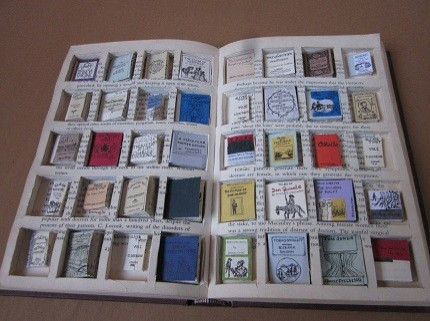Q&A With Rachel Walsh On Bringing Charles Dickens Into the 21st Century

When she was given the project of explaining a bit of modern technology to a person who lived and died before 1900, Rachel Walsh created a version of the Kindle to show Charles Dickens in terms that he would understand -- 40 detailed miniature books placed inside a large hardback. She made tiny versions of the actual covers of the books, which were either those that the 19th-century author wrote, his favorite childhood books, or ones in Walsh's collection.
Walsh just finished her second year at Cardiff School of Art & Design in England, where she is an Illustration student. She is originally from South West London, but living in Cardiff while she does her degree.
For more of her work, see her blog at rachelwalshillustration.tumblr.com.
INTERNATIONAL BUSINESS TIMES: How did you think of making 40 mini-books and putting them inside an oversized hardcover book as a way of explaining the Kindle to Charles Dickens?
RACHEL WALSH: The brief was to Explain a piece of modern technology to someone who lived and died before 1900. I originally thought of doing an animation showing the three main features of the Kindle, showing Charles how the Kindle could make his life easier. But the problem remained that this animation was not explaining the Kindle to Charles in a way that he could understand, in terms of things he could relate to. I kept thinking the Kindle's just lots of little books inside one big one! and I ended up using that idea for the project, however simple it sounded!
IBTIMES: What was the most painstaking part of this project?
WALSH: There were two most painstaking parts of the project. The first was cutting out the 40 windows in the hardback book that the little books would sit in. I did this by hand, obtaining many cuts from my scalpel! Measuring out the windows wasn't too bad, but cutting out the pages from them took ages.
The other was making the book covers with the most detail. Some of the book covers were quite complex with whole scenes on them -- streets, people ... These were tricky. I messed up a few covers when my 0.03 nib pen wasn't small enough and had to redo them.
IBTIMES: Which was the most fun book to create?
WALSH: Dickens's The Old Curiosity Shop was fun to make, as it's got a little house and street on it. I liked making Catcher in the Rye and Tigger Comes to the Forest, as they've both got sentimental value for me. I thought Tigger and Pooh Bear looked quite cute that small!
IBTIMES: As an illustrator, what can you do on the Web that you can't do in print?
WALSH: I think the main plus the Web provides illustrators is the sheer number of people that your work can reach. Getting your work into any form of print is always great, but your work doesn't have the same audience size as when it's online! My blog has been the vehicle for any online success I've had with this project which has been pretty overwhelming, and shows the amazing power of the Internet!
IBTIMES: I'm curious for your take on how illustrations are used electronically. Do you think there is increasing appreciation for illustrations on the Web, or even more so on e-readers?
WALSH: I think there is an increasing appreciation for illustrations on the Web. The phenomenon of the Web is taken for granted now, so now people seem to like a website or blog more if has illustrations/innovative design incorporated, because it makes that site stand out. I think illustration is very transferable between print and the Web - why should illustration stop at paper? Illustrations in e-readers will enrich a user's experience in the same way that illustrations within a book would do, and I think it's a positive thing that illustration is finding itself present in so many different media types.
IBTIMES: Do you think Charles Dickens would have used a Kindle?
WALSH: Dickens used to travel and do book readings, so I think if he could get his head round the technology it would be a useful tool for him! Plus then he could have all his books with him wherever he went!
© Copyright IBTimes 2024. All rights reserved.





















